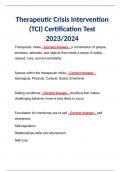Summary
Summary research methods for the behavioral sciences (5E, Charles Stangor)
- Course
- Institution
- Book
Summary of the book Research methods for the behavioral sciences (5th edition, by Charles Stangor). This book is used during the cursus Onderzoeksmethoden: theorie en ethiek, which is a second year cursus when you study Psychology at the University of Groningen. This summary includes all the chapte...
[Show more]













